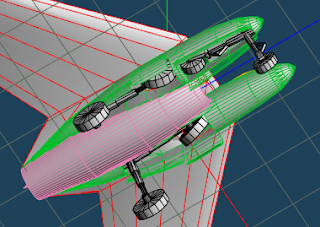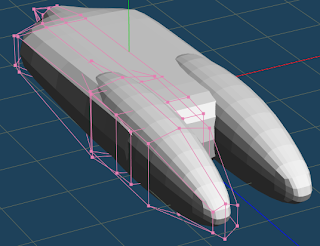The Lippisch P.13a is a very interesting Luft'46 design. Had this thing been built, it would have been made mostly out of wood. It would have been powered by a ramjet engine that uses powdered coal as its main fuel! To get this thing up to speed to make the ramjet work, it would have used a small version of the rocket engine used by the ME163 Komet.
It had no landing gears. Instead, it uses three landing skids. I therefore assume this aircraft required a grassy surface to land on. Asphalt or concrete would have ruined the skids.
Wind tunnel tests shows that the frame of the P.13a could reach Mach2.
It would have been armed by a pair of 30mm cannons.
I designed the wireframes using Metaseq. The unrolling/unfolding, I used Pepakura. Finally, the skins were made using Inkscape.
I. Building the main fuselage
I originally designed the main fuselage using the traditional lateral and horizontal spars. Unfortunately, although they did the job, it was terribly difficult to assemble the left and right outer skins. I experimented a bit by using the accordion like spars seen in the picture above.
As you can see, the accordion like spars provide enough volume and as a side effect, it prevents the glue tabs from folding inwards. This 'should' make attaching the other half of the fuselage a lot easier.
And hey, it works!
II. Building the wings
Now, on to the wings.
Unlike the fuselage, the traditional spars worked quite well.
Wings done!
III. The rudder / cockpit
Like the wings, the rudder is comprised of three spars. That small tube shown in the picture above is the booster rocket exhaust.
Make sure to insert the spars into the rudder/cockpit first before you attach the rocket booster!
IV. Intake and Landing Skid
Some knick knacks.
V. Putting it all together
First, attach the wings to the fuselage.
Second, attach the rudder/cockpit.
Third, the intake.
Lastly, the landing skid. Note that it is important to attach the intake first before attaching the landing skid!
VI. The Trolley
Trolley assembly is pretty straightforward....
VII. All done!
For the camo, I used the RLM74/76/81 color scheme. Squadron markings are of the JG52, with matching defense of the reich band.
There's something terribly wrong with the printout. The colors are not supposed to be muted like this. I think the blame lies on the card stock I used. The card stock seems to react with the HP92/93 ink.
I thoroughly enjoyed designing and building this. If you would like to try out my design, you can download the model from the following link:























































